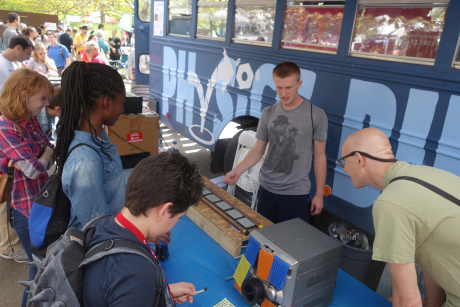CHESS X-rays show how to grow crystals from crystals
To apply these materials in emerging nanotechnologies, scientists need to better understand their structure, their corresponding functions and how they pack together.
To apply these materials in emerging nanotechnologies, scientists need to better understand their structure, their corresponding functions and how they pack together.
Syracuse, N.Y. — The severed head of a fish arrived at Karin Limburg's doorstep one Sunday morning in 2003.
It was an offering she couldn't refuse.
That Atlantic salmon was among the first that Limburg studied in her decade of work on how fish migrate between Onondaga and Oneida lakes, and the adjoining rivers and streams.
The Sept. 27 workshop was one in a series of professional growth and development opportunities for science teachers, offered by the outreach program of the Cornell Laboratory for Accelerator-based Sciences and Education (CLASSE).
Ithaca teachers get $25K for classroom projects
ITHACA – Grants worth $25,000 have been awarded for classroom projects linking Ithaca City School District teachers with the unique talents of community partners.
The 17 teacher grants dispersed by the Ithaca Public Education Initiative go to local teachers for projects to be implemented this school year and costing no more than $1,500. The competitive grants will enhance learning for approximately 1,700 Ithaca students, according to IPEI.
The upgrade involves replacing old magnetic devices called wigglers with smaller, better ones called undulators, outfitted along the beam pipe in CESR (Cornell Electron Storage Ring). As continuously circulating electron or positron beams shoot through the undulators, arrays of magnets inside wave the beams back and forth. It’s this movement that produces the X-rays needed for CHESS experiments.
Brian Crane, professor of chemistry and chemical biology, led one study and co-authored a follow-up on a spectroscopic method that detects subtle changes to copper-containing proteins in solution. He and Jack Freed, the Frank and Robert Laughlin Professor of Physical Chemistry, have developed the method together with Petr Borbat, associate director of Cornell’s National Biomedical Center for Advanced ESR Technology.
A billion times smaller than a raindrop is the volume of an E. coli cell. And another million times smaller would be a reactor small enough to study isolated nanoparticles. Add to that the challenge of making not just one of these tiny reactors, but billions of them, all identical in size and shape. Researchers at Cornell have done just that.
A team led by Tobias Hanrath, associate professor of chemical and biomolecular engineering, has demonstrated controlled fusion of semiconductor quantum dots within a nanoreactor cage of rusty particles.

On its maiden voyage out of Ithaca, the Ithaca Physics Bus, whose mission is to bring science to the public, brought some 20 exhibits that students in the JunkGenies Greater Ithaca
But despite this importance, existing methods to probe such events, involving strain rates of 103-105 s-1, provide only limited or indirect information about the atomic-scale rearrangement that materials undergo.
For example, the skins of many plants and animals have intricate microscale features that give rise to useful properties such as repelling water, adhesion, color-adaptation, camouflage, and resistance to wear or degradation. Try as we have, it is still very difficult or impossible to achieve efficient top–down fabrication processes.